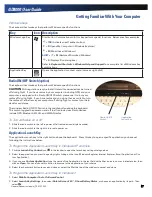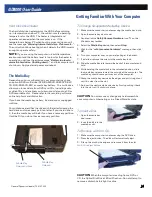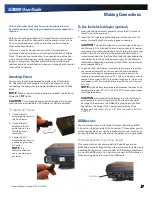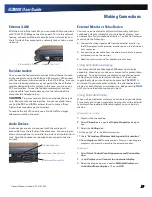
General Dynamics Itronix | 72-0137-003
GD8000 User Guide
Auto Dim Feature
To save the battery power, your computer automatically dims
the display when the computer is not attached to external
power.
NOTE
You may still use the display brightness function keys
(
FN+F6
and
FN+F7
) to adjust display brightness.
See
Managing Power
for more information on power
management features.
Simultaneous or Extended Display
This computer supports simultaneous LCD and external
display output via the external monitor port located on the
back edge of the computer. You can also connect other
output display devices such as LCD projection panels for large
audience presentations. See
Attaching an External Monitor or
Video Device
for more information.
FEATURE
When using an external monitor you can extend
your desktop. This allows you to open and view one program
on the external monitor while viewing a different program on
your laptop’s display.
Windows XP and Vista:
1.
Right click on the desktop.
2.
Select
Properties
to open the
Display Properties
dialogue
box.
3.
Select the
Settings
tab.
4.
Click on the “
2
” in the Monitors section.
5.
Check “
Extend my Windows desktop onto this monitor
”.
6.
Select
Apply
and
OK
to save and exit. Now you can drag the
programs you want to view onto the external monitor.
Windows 7:
1.
Select
Start, Control Panel, Appearance and Personaliza-
tion
.
2.
Under
Display
select
Connect to an external display
.
3.
Select the drop-down menu next to
Multiple Displays
and
click
Extend these displays
. Then click
OK
.
LCD Heater
The GD8000 has a CCFL heater to improve display brightness
in a cold environment. The heater includes a film and heater
strip that is bonded over the CCFL area of the display. It is
designed to turn on when the temperature is cold enough
to impact display brightness and does not require user
intervention.
Cursor Visibility
To improve the visibility of the mouse cursor, you should:
Enable the “
Pointer Trails
” feature to add trailing cursors
Use a slow or medium speed/sensitivity level
You can combine a higher level of acceleration with a slow
or medium speed/sensitivity level. This allows you to move
the mouse cursor quickly by increasing your finger pressure,
while still providing a finer degree of control when you apply
minimum pressure.
NOTE
To change the speed of the mouse, do the following:
Windows XP:
Select
Start,
Control Panel
,
Printers and Other
Hardware
, and then choose
Mouse
. On the
Mouse Properties
window, select the
Pointer Options
tab to make cursor visibility
adjustments.
Windows Vista and Windows 7:
Select
Start
,
Control Panel,
Hardware and Sound
, and then choose
Mouse
. On the
Mouse
Properties
window, select the
Pointer Options
tab to make cur-
sor visibility adjustments.
Lid Switch
Your computer has a lid switch that can automatically suspend
and resume your computer when you close and open the
display. To change the power management settings for the lid
switch, perform the following:
For Windows XP:
1.
On the System Tray area of the Taskbar, right-click the
Power
Saver
icon ( or ).
2.
From the menu, select
Configure Power Settings
.
3.
Select the
Advanced
button.
4.
Select what you want to happen when you open or close the
display lid.
For Windows Vista and Windows 7:
1.
On the System Tray area of the Taskbar, right-click the
DynaPower
icon
.
2.
At the top of the grid, select the appropriate
Power
plan.
3.
Select the desired action settings for both battery or AC power.
4.
In the
Power buttons and lid
section, select the
Lid Open Ac-
tion
and
Lid Close Action
.
5.
Select
Save Changes
and repeat steps 2 through 4 until all
power plan settings you wish to modify.
NOTE
The
Lid Close Action
default is
Standby
for Windows XP and
Sleep
for Window Vista/Windows 7. The default
Lid Open Action
is
Do Nothing
.
Getting Familiar With Your Computer






























